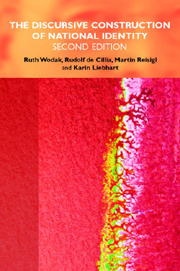Book contents
- Frontmatter
- Contents
- Preface to the Second, Extended Edition
- Acknowledgements
- 1 Introduction
- 2 The Discursive Construction of National Identity
- 3 On Austrian Identity: The Scholarly Literature
- 4 The Public Arena: Commemorative Speeches and Addresses
- 5 Semi-Public Discussions: The Focus Group Interviews
- 6 Semi-Private Opinions: The Qualitative Interviews
- 7 Conclusion: Imagined and Real Identities – the Multiple Faces of the homo nationalis
- 8 The ‘Story’ Continues: 1995–2008
- Appendix 1 Speeches Studied in Chapter 4
- Appendix 2 Speeches and Interviews Studied in Chapter 8
- Bibliography
- Index
6 - Semi-Private Opinions: The Qualitative Interviews
Published online by Cambridge University Press: 12 September 2012
- Frontmatter
- Contents
- Preface to the Second, Extended Edition
- Acknowledgements
- 1 Introduction
- 2 The Discursive Construction of National Identity
- 3 On Austrian Identity: The Scholarly Literature
- 4 The Public Arena: Commemorative Speeches and Addresses
- 5 Semi-Public Discussions: The Focus Group Interviews
- 6 Semi-Private Opinions: The Qualitative Interviews
- 7 Conclusion: Imagined and Real Identities – the Multiple Faces of the homo nationalis
- 8 The ‘Story’ Continues: 1995–2008
- Appendix 1 Speeches Studied in Chapter 4
- Appendix 2 Speeches and Interviews Studied in Chapter 8
- Bibliography
- Index
Summary
METHODOLOGY
As one of the aims of our study was to include ‘subjective’ aspects of the discursive construction of Austrian identity we carried out a number of topic-orientated qualitative interviews, to determine informants' views, attitudes and levels of awareness. The interviews took place in a relatively relaxed and flexible setting, which enabled the interviewer to react to unanticipated turns in the conversation and provided ample opportunity for feedback and clarification of ambiguous points.
Since the interviews were structured to resemble informal open-ended, private conversations there was little observable pressure to articulate statements conforming to group opinions or politically correct statements, as observable in focus group participants. Due to the dialogic nature of the interviews, moreover, respondents were able to produce sequences of thoughts and utterances without being interrupted or being pushed in a certain direction by other participants.
Of course, we make no claim to present a representative sample. The material collected in these interviews can, however, throw light on how patterns of national identification and identity find expression in individuals; and can illustrate the subjective dimension of the contents and figures of argumentation, and the construction of Austrian identity conceived on a more ‘macro’ level. It can also help trace the diffusion of specific information units about Austrian identity from public (media) or semi-public discourse down to the opinions expressed by individuals.
- Type
- Chapter
- Information
- The Discursive Construction of National Identity , pp. 146 - 185Publisher: Edinburgh University PressPrint publication year: 2009

